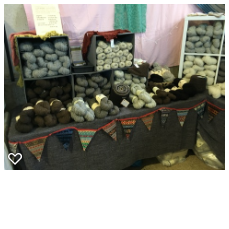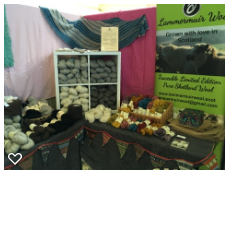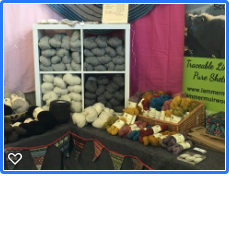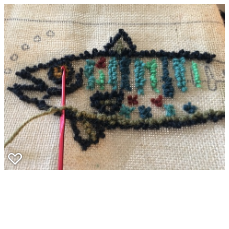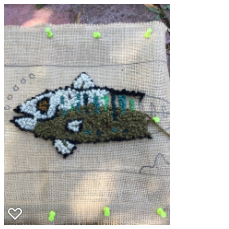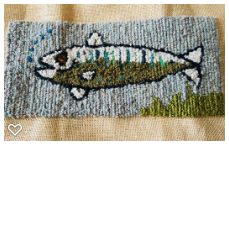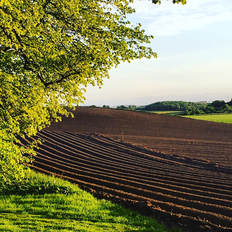|
2018 was our first visit as stallholders at Woolfest. I have visited a few times in the past; as a customer and also as a helper on the Shetland Sheep Society stand. I have always come away awestruck by just how creative and entrepreneurial so many people are, and inspired to do more myself. Applying to 'do' Woolfest was a big decision: it is a multi-day undertaking requiring accommodation and paid-for doggy-care, as well as travel costs and stall fees. We were encouraged to apply for a mini-stall; an initiative run by Woolfest to encourage new and smaller sellers. I worked hard on the application and was both excited and scared to find out that I had gained a place at this year's event. Despite still being short of stock (because my missing 16kg of spun wool is still mislaid by Parcelforce), I worked hard in the weeks leading up to the event: weighing, re-skeining; dyeing; drying; labelling .... We set up on the Thursday afternoon and were finished quite quickly which meant we could help out our neighbouring stall-holders. Especially Paolo, as he has Long Arms Which Can Reach Things. Our stall didn't look too bad and - as we were in a bit of a dark corner - we felt we had lightened it up as best we could. We'd booked a farm cottage about 30 minutes stunning drive away, which was blissfully quiet. The Festival is open Friday and Saturday, and it was great to meet people who were interested in the wool and its provenance. People had questions (some challenging ones!) about sheep-farming practice and we were able to bust some myths. The quality of the wool speaks for itself and people - some of whom expect Shetland wool to be 'scratchy' were pleasantly surprised at how soft it is. The dyed wool went down well and people seemed able to imagine how they could work the greys, moorits, natural whites and dyed shades together. The names of the shades, and the inspiration behind them was also a great talking point. It was exhausting and the days seemed very long - something to do with standing on concrete, I think! It was an enjoyable event for us - we got to meet new customers (and old ones), as well as some useful conversations with other stall holders and designers. I managed to avoid buying much wool (just some John Arbon Devonia for another shawl, and some Blane Norwegian wool to finish a sweater I'm working on. But I did buy a wee hook-rug kit in the shape of a fish. It's now finished and I love it! On the Sunday, we ventured to the Woolclip's shop in Caldbeck which is definitely worth a visit.
We took this photo of a neighbouring field last month - when everything was still very fresh and green. It does not look the same now! The lambs - which were so tiny back in April have really grown, with some of the larger lambs now almost as big as their mothers. To watch two huge lambs diving for their mother's milk with such strength that they lift the ewes back-end off of the ground is funny to see, but the ewes are starting to look a bit fed up of the whole business of providing milk to such boisterous and independent off-spring. We will probably wean off the lambs in late August, moving the ewes a few miles away to a different field, where they have nothing to do but eat and regain condition. We lost two lambs over the last few months - and each occasion was very sad. One lamb developed CCN - a brain illness - and the other who we nursed carefully for over a month - never really recovered from being abandoned by her mother (and stolen by another ewe) at birth. Both times we were able to take the lambs to our local vet to have them euthanised. It's very upsetting for us as we spend a lot of time with our sheep (and even more with the ill ones!) and grow attached to them. We had to bottle feed two lambs for the first momth or so after they were born. The ewe birthed twins but would only ever feed one. If the second lamb tried to feed she would butt it away. However, she did not reject the lamb outright (as sometimes happens). It turned out that the ewe really only just had enough milk for one lamb and so had made a decision not to feed the second. There's a wee film clip below showing the paler lamb (the one not being fed by mum) looking a lot quieter and less active than her sister. We kept the three of them in a pen for over a week so that mum got used to the idea of both lambs being around. We ended up feeding both of them and the ewe later came to allow both lambs to nurse for what milk there was. Four feeds a day become three, then two, then one and now both lambs are fully independent. Having been bottle-fed, they are irrepressible, and the first to run up when we arrive at the field each day. The lambs are currently called Tillie and TillieToo but we will have to find proper names, soon. Here is TillieToo getting stuck in to the bottle... It was a tricky lambing period over all with some new challenges for us but lambs now seem healthy, happy and are growing fast.
|
Archives
January 2024
Categories |
Proudly powered by Weebly


